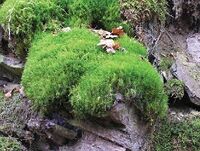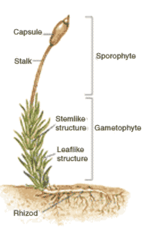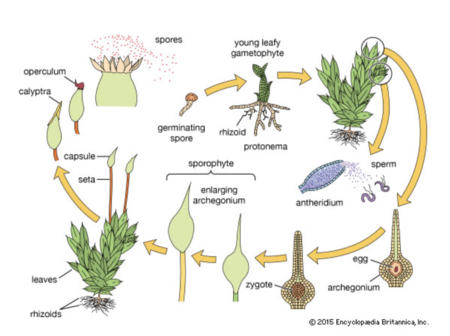Moss: Difference between revisions
No edit summary |
mNo edit summary |
||
| (180 intermediate revisions by 11 users not shown) | |||
| Line 1: | Line 1: | ||
{| class="wikitable" style="text-align:center; float:right; margin-left: 10px; | |||
|+ !colspan="2" style="min-width:12em; text-align: center; background-color: rgb(153,255,153)|'''Bryophyta''' | |||
|- | |||
|colspan="2" |[[File:Moss.jpg |200px|thumb|left| Sphagnum "peat moss"]] | |||
|- | |||
!style="min-width:6em;background-color: rgb(180,250,180) |Kingdom: | |||
|style="min-width:6em;text-align: left; |[[Plantae|Plantae]] | |||
|- | |||
!style="min-width:6em; |Phylum: | |||
|style="min-width:6em;text-align: left; |Bryophyta | |||
|- | |||
!style="min-width:6em; |Classes: | |||
|style="min-width:6em;text-align: left; |[[Andreaeobryopsida|Andreaeobryopsida]] | |||
[[Andreaeopsida|Andreaeopsida]] | |||
[[Bryopsida|Bryopsida]] | |||
[[Oedipodiopsida|Oedipodiopsida]] | |||
[[Polytrichopsida|Polytrichopsida]] | |||
[[Sphagnopsida|Sphagnopsida]] | |||
[[Takakiopsida |Takakiopsida ]] | |||
[[Tetraphidopsida|Tetraphidopsida]] | |||
|- | |||
|colspan="2" |Source: Integrated Taxonomic Information System<ref name="ITIS">[https://www.itis.gov/servlet/SingleRpt/SingleRpt?search_topic=TSN&search_value=977384#null "Integrated Taxonomic Information System - Report"], ''ITIS'' USGS Open-File Report 2006-1195: Nomenclature", ''USGS'', n.d.. Retrieved 3/10/2023.</ref> | |||
|} | |||
==Physical Characteristics== | |||
[[File:mossstructure.png|left|Basic moss structure.|thumb|150px|]] | |||
===Structure=== | |||
Mosses (Bryophyta) are non-vascular plants in the broader parent group Bryophyta, which includes Liverworts and Hornworts.<ref name="Raven2013" >Raven, P. H., R. F. Evert, and S. E. Eichhorn. 2013. ''Biology of plants''. Eighth edition. W.H. Freeman and Company Publishers, New York.</ref> They are the most specious of the three divisions of bryophytes, with over 12,000 species worldwide. <ref>Crandall-Stotler, B. J., and S. E. Bartholomew-Began. 2007. Morphology of Mosses (Phylum Bryophyta). ''Flora of North America'' 27.</ref> Mosses are herbaceous photosynthetic plants that absorb water and nutrients through their leaf-like structures. The species are non-vascular, due to lacking lignified water and nutrient-conducting tissues called xylem and phloem. <ref>Ligrone, R., J. G. Duckett, and K. S. Renzaglia. 2000. Conducting tissues and phyletic relationships of bryophytes. ''Philosophical Transactions of the Royal Society of London'' Series B: ''Biological Sciences'' '''355''':795–813. | |||
).</ref> Additionally, mosses lack true roots, instead, they have multicellular thread-like structures called rhizoids that anchor the plant to the substrate.<ref name="Raven2013" /> | |||
[[https:// | ===Life Cycle=== | ||
[[File:Moss_3.png|Moss Life Cycle.|thumb|left|450px]] | |||
Mosses are known to reproduce in many different ways, but the most common way is by their spores to spread by wind dispersal. <ref name="McCune 2016"> McCune , B., and K. Whitbeck. 2016, May 24. Living in the Land of Mosses. https://pnwhandbooks.org/plantdisease/pathogen-articles/nonpathogenic-phenomena/living-land-mosses. </ref> Like other bryophytes, mosses are dominated by their haploid, gametophytic generation and reproduce using spores. Similar to vascular plants, mosses exhibits alternating heteromorphic generations. The gametophyte generation is typically larger and independent, while the sporophyte generation is smaller and nutritionally dependent on the parent gametophyte. <ref name="Cove2016">Cove, D., M. Bezanilla, P. Harries, and R. Quatrano. 2006. Mosses as Model Systems for the Study of Metabolism and Development. ''Annual Review of Plant Biology'' '''57''':497–520.</ref> | |||
The life cycle begins when haploid spores are released from the capsule of the mature sporophyte and germinate into protonemata, and then later into male and female gametophytes. The gametophytes have either male (antheridia) or female (archegonia) reproductive organs. <ref name="Reski 1998">Reski, R. 1998. Development, Genetics and Molecular Biology of Mosses. ''Botanica Acta'' 111:1–15.</ref> Haploid sperm are released from the mature antheridia and swim in the water to the archegonia which house the non-motile egg. Fertilization occurs in the archegonium to produce a diploid zygote, which divides mitotically to form a young sporophyte. As it matures, the archegonium enlarges to protect the sporophyte until maturation is reached. The mature sporophyte consists of the stalk and capsule (sporangium). Meiosis occurs within the sporangium, producing haploid spores which will be released to form the gametophytic generation. <ref name="Raven2013" /> | |||
==Environmental Role== | |||
:Mosses play a vital role to the environment through their purpose of absorption. By having this big of a role in the ecosystem, absorption helps to combat erosion by stabilizing [[soil]] and reducing the risks of flooding by absorbing excess water. Their rhizoids can hold on to substrates such as [[clay]], [[gravel]], and [[sand]].Mosses living situation is beneficial to the environment because they can live anywhere, including areas with extreme conditions such as the Artic, deserts, and tropical regions. <ref name="McCune 2016"> McCune , B., and K. Whitbeck. 2016, May 24. Living in the Land of Mosses. https://pnwhandbooks.org/plantdisease/pathogen-articles/nonpathogenic-phenomena/living-land-mosses. </ref> Mosses are an important carbon sink and could potentially play an important role in combating climate change. Additionally, mosses can filter other pollutants like excess sediment and salt used on roadways. Within the local environment, mosses also have the ability to create humid microhabitats. <ref name="Crooks2021">PerezJI. 2021, February 22. Bryophytes. Text, ''Smithsonian Tropical Research Institute''. https://stri.si.edu/story/bryophytes.</ref> In some boreal and arctic ecosystems, mosses are the primary plant type and are responsible for establishing soil layers, providing nutrients and habitats for new seeds to germinate, and providing areas for microinvertebrates to thrive. <ref name="Turetsky2012">Turetsky, M. R., B. Bond-Lamberty, E. Euskirchen, J. Talbot, S. Frolking, A. D. McGuire, and E.-S. Tuittila. 2012. The resilience and functional role of moss in boreal and arctic ecosystems. New Phytologist 196:49–67.</ref> | |||
==References== | |||
{{reflist}} | |||
Latest revision as of 14:38, 2 April 2025
 | |
| Kingdom: | Plantae |
|---|---|
| Phylum: | Bryophyta |
| Classes: | Andreaeobryopsida |
| Source: Integrated Taxonomic Information System[1] | |
Physical Characteristics

Structure
Mosses (Bryophyta) are non-vascular plants in the broader parent group Bryophyta, which includes Liverworts and Hornworts.[2] They are the most specious of the three divisions of bryophytes, with over 12,000 species worldwide. [3] Mosses are herbaceous photosynthetic plants that absorb water and nutrients through their leaf-like structures. The species are non-vascular, due to lacking lignified water and nutrient-conducting tissues called xylem and phloem. [4] Additionally, mosses lack true roots, instead, they have multicellular thread-like structures called rhizoids that anchor the plant to the substrate.[2]
Life Cycle

Mosses are known to reproduce in many different ways, but the most common way is by their spores to spread by wind dispersal. [5] Like other bryophytes, mosses are dominated by their haploid, gametophytic generation and reproduce using spores. Similar to vascular plants, mosses exhibits alternating heteromorphic generations. The gametophyte generation is typically larger and independent, while the sporophyte generation is smaller and nutritionally dependent on the parent gametophyte. [6]
The life cycle begins when haploid spores are released from the capsule of the mature sporophyte and germinate into protonemata, and then later into male and female gametophytes. The gametophytes have either male (antheridia) or female (archegonia) reproductive organs. [7] Haploid sperm are released from the mature antheridia and swim in the water to the archegonia which house the non-motile egg. Fertilization occurs in the archegonium to produce a diploid zygote, which divides mitotically to form a young sporophyte. As it matures, the archegonium enlarges to protect the sporophyte until maturation is reached. The mature sporophyte consists of the stalk and capsule (sporangium). Meiosis occurs within the sporangium, producing haploid spores which will be released to form the gametophytic generation. [2]
Environmental Role
- Mosses play a vital role to the environment through their purpose of absorption. By having this big of a role in the ecosystem, absorption helps to combat erosion by stabilizing soil and reducing the risks of flooding by absorbing excess water. Their rhizoids can hold on to substrates such as clay, gravel, and sand.Mosses living situation is beneficial to the environment because they can live anywhere, including areas with extreme conditions such as the Artic, deserts, and tropical regions. [5] Mosses are an important carbon sink and could potentially play an important role in combating climate change. Additionally, mosses can filter other pollutants like excess sediment and salt used on roadways. Within the local environment, mosses also have the ability to create humid microhabitats. [8] In some boreal and arctic ecosystems, mosses are the primary plant type and are responsible for establishing soil layers, providing nutrients and habitats for new seeds to germinate, and providing areas for microinvertebrates to thrive. [9]
References
- ↑ "Integrated Taxonomic Information System - Report", ITIS USGS Open-File Report 2006-1195: Nomenclature", USGS, n.d.. Retrieved 3/10/2023.
- ↑ Jump up to: 2.0 2.1 2.2 Raven, P. H., R. F. Evert, and S. E. Eichhorn. 2013. Biology of plants. Eighth edition. W.H. Freeman and Company Publishers, New York.
- ↑ Crandall-Stotler, B. J., and S. E. Bartholomew-Began. 2007. Morphology of Mosses (Phylum Bryophyta). Flora of North America 27.
- ↑ Ligrone, R., J. G. Duckett, and K. S. Renzaglia. 2000. Conducting tissues and phyletic relationships of bryophytes. Philosophical Transactions of the Royal Society of London Series B: Biological Sciences 355:795–813. ).
- ↑ Jump up to: 5.0 5.1 McCune , B., and K. Whitbeck. 2016, May 24. Living in the Land of Mosses. https://pnwhandbooks.org/plantdisease/pathogen-articles/nonpathogenic-phenomena/living-land-mosses.
- ↑ Cove, D., M. Bezanilla, P. Harries, and R. Quatrano. 2006. Mosses as Model Systems for the Study of Metabolism and Development. Annual Review of Plant Biology 57:497–520.
- ↑ Reski, R. 1998. Development, Genetics and Molecular Biology of Mosses. Botanica Acta 111:1–15.
- ↑ PerezJI. 2021, February 22. Bryophytes. Text, Smithsonian Tropical Research Institute. https://stri.si.edu/story/bryophytes.
- ↑ Turetsky, M. R., B. Bond-Lamberty, E. Euskirchen, J. Talbot, S. Frolking, A. D. McGuire, and E.-S. Tuittila. 2012. The resilience and functional role of moss in boreal and arctic ecosystems. New Phytologist 196:49–67.